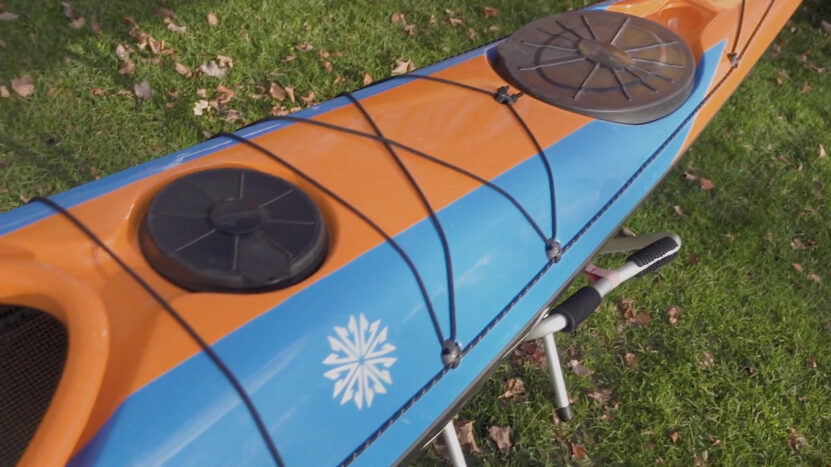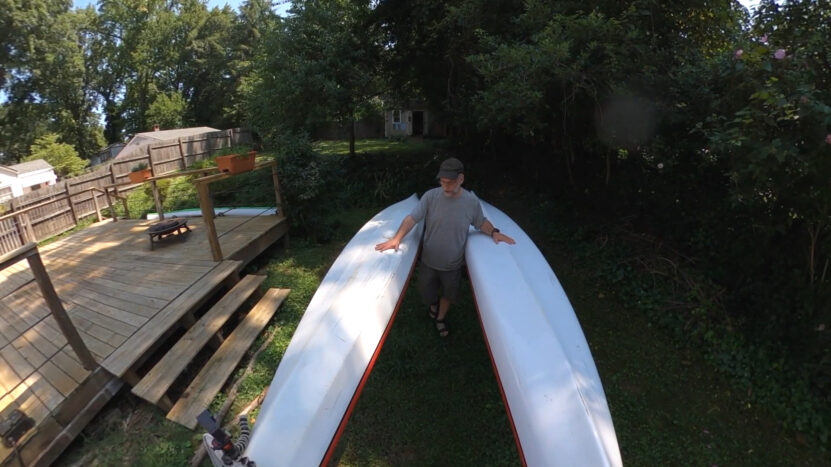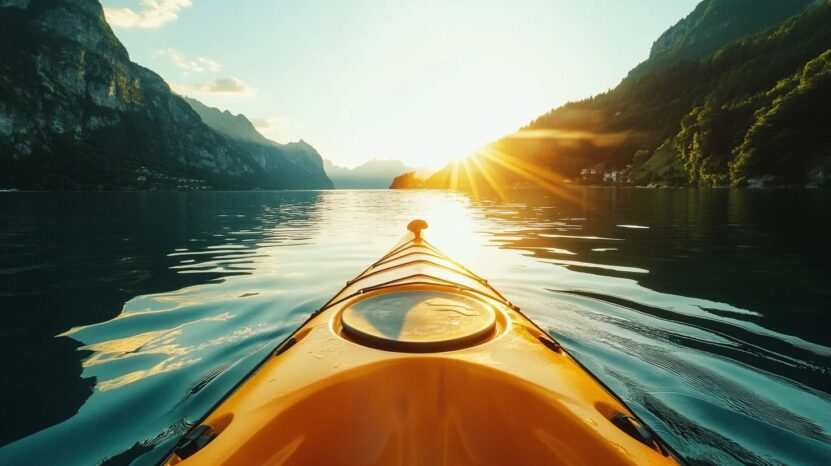Kayaking is a versatile and adventurous water sport that involves paddling a small craft, known as a kayak, through various water bodies.
The origins of kayaking trace back to Inuit peoples who designed these crafts for hunting in Arctic waters.
Today, kayaking has become a popular recreational activity, with numerous health, mental, and fitness benefits, enjoyed by people worldwide in a variety of forms and environments.
Kayak Anatomy Overview
Being fully aware of the anatomy of a kayak is essential for both beginners and experienced kayakers because the design of each part influences how the kayak performs in various environments.
Knowing the basic components helps you select the right kayak based on your needs and ensures you can handle different water conditions with confidence.
- Hull shape
- Cockpit size
- Additional features like:
- Rudders
- Skegs
The kayak’s anatomy includes several key parts, such as:
- Hull
- Bow and stern
- Cockpit
- Deck
These elements work together to create a balanced kayak that meets your specific paddling needs. For example, the type of hull can determine whether a kayak is better suited for calm or rough water.
Accessories like foot braces, rudders, and skegs also play a significant role in how well you control the kayak, especially in windy conditions or fast currents.
Hull

The hull is the body of the kayak, and it plays a vital role in determining how the kayak performs on water.
There are two primary types of hulls:
- Displacement
- Planing
Displacement hulls are typically used in touring and sea kayaks because they allow for better tracking and speed.
Planing hulls, on the other hand, are flatter and used in recreational kayaks for improved stability and maneuverability.
Bow and Stern

The bow and stern refer to the front and rear ends of the kayak, respectively.
The bow is usually pointed to allow the kayak to cut through water more efficiently, while the stern is often tapered to reduce drag and improve tracking.
A well-designed bow and stern are essential for speed and smooth handling, especially in rough or open water conditions.
Cockpit

The cockpit is where the paddler sits, and its design varies depending on the type of kayak.
Recreational kayaks typically have larger cockpits, which allow for easier entry and exit and more freedom of movement.
In contrast, sea and whitewater kayaks often have smaller cockpits to provide more control and prevent water from entering the boat.
Deck

The deck is the top part of the kayak, and it includes various features to enhance functionality.
Bungee cord rigging is commonly found on the deck, providing a convenient storage option for gear.
Deck hatches offer access to dry storage compartments within the kayak, allowing you to safely store equipment and personal items.
Rudder and Skeg

Both the rudder and skeg help improve the kayak’s tracking and control in different water conditions.
A rudder is a movable fin attached to the stern, used primarily for steering.
It is particularly helpful in windy conditions when it becomes difficult to maintain a straight course.
A skeg, on the other hand, is a fixed fin located under the kayak that helps with tracking in open water by reducing the effects of wind and currents.
Foot Braces and Pedals

Foot braces and pedals are adjustable parts that provide paddlers with greater stability and power during each stroke.
These components are often linked to rudder systems, allowing the paddler to control the rudder by pushing on the foot pedals.
Proper foot positioning ensures comfort and efficiency during long paddling sessions.
Chine

The chine is the edge where the hull meets the side of the kayak.
There are soft chines, which offer rounded edges for enhanced stability, and hard chines, which have sharper edges for increased maneuverability.
Hard-chined kayaks are better suited for more experienced kayakers who need agility in rough waters.
Rocker
The rocker refers to the curvature of the kayak’s hull from the bow to the stern.
A higher rocker means the kayak has more curves, which enhances maneuverability, making it easier to navigate through rough water or around obstacles.
Conversely, kayaks with less rocker tend to track better, making them ideal for long-distance paddling.
Bulkheads

Bulkheads are internal walls that create watertight compartments within the kayak.
These compartments provide buoyancy in case of capsizing and offer additional storage space.
Bulkheads are especially important in touring and sea kayaks, where keeping gear dry is crucial during long trips.
What are Kayak Accessories?
Now let us take a look at some common accessories:
Paddle

A paddle is the primary tool used to propel the kayak. It consists of a shaft and two blades.
The blades come in various designs, such as feathered, symmetrical, and asymmetrical, to cater to different paddling styles and water conditions.
A feathered paddle has blades offset at an angle to reduce wind resistance, while an asymmetrical blade offers smoother entry into the water.
Spray Skirt

A spray skirt is an essential accessory for sit-inside kayaks, as it helps keep water out of the cockpit. Made of waterproof material, it fits snugly around the paddler’s waist and attaches to the kayak’s cockpit rim.
Spray skirts are especially important for whitewater and sea kayaking, where rough conditions may lead to water splashing into the cockpit.
Life Jacket (PFD)

A life jacket or Personal Flotation Device (PFD) is a critical safety accessory for all kayakers.
It ensures that, in the event of capsizing, the kayaker will remain afloat.
PFDs come in various designs tailored to kayaking, with some offering additional pockets for storing small items.
Dry Bags and Waterproof Storage

Dry bags and waterproof storage containers are used to keep valuables, clothing, and other essentials dry during kayaking trips.
These bags are made from durable, waterproof materials and come in different sizes to accommodate various gear.
They are especially useful for multi-day kayaking trips where exposure to water is inevitable.
The Bottom Line
Understanding the parts of a kayak and its accessories is key to improving your paddling experience.
Each component plays a role in enhancing stability, speed, and overall comfort on the water.

